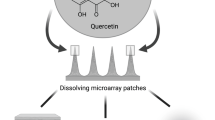Abstract
Laminated films composed of drug-containing reservoir layer and drug-free membrane were prepared. Zero-order drug release with lag time was achieved by laminating drug-free film onto the reservoir layer, while burst effect was observed on cast-on film. The rate controlling membrane was either attached to or cast directly into the reservoir. The release rate was independent on the reservoir composition but dependent on the composition of rate-controlling membrane. In growth inhibitory test of cephalexin from Eudragit RS film toStreptococcus Mutans, the disk even after release test for 72 hours showed more bacterial growth inhibition than that of control. Permeation of drug through rat skin was proportional to the HPC fraction in the film. We could control the release of cephalexin from the film by changing the fraction of Eudragit RS, HPC and DEP content. Consequently, Eudragit RS/HPC film was found to be very effective system for local delivery of drugs.
Similar content being viewed by others
References Cited
Applezweig, N., U. S. pat., 3,536,809 (1970).
Armstrong, P. W. and Marks, G. S., Pharmacokinetic-hemodynamic studies of nitroglycerin ointment in congestive heart failure.Am. J. Cardiol., 46, 670–675 (1980).
Aungst, B. J., Blake, J. A., Rogers, N. J., and Hussain, M. A., Transdermal oxymorphone formulation development and methods for evaluating flux and lag times for two skin permeation-enhancing vehicles.J. Pharm. Sci., 79, 1072–1076 (1990).
Barry, Y. W. and Bennet, S. L., Effect of penetration enhancers on the permeation of mannitol, hydrocortisone and progestrone through human skin.J. Pharm. Pharmacol., 39, 535–546 (1987).
Bodmeir, R. and Paeratakul, O., Drug release from laminated polymeric films prepared from aqueous latexes.J. Pharm. Sci., 79, 32–36 (1990).
Borodokin, S. and Tucker, F. E., Drug release from hydroxypropyl cellulose-polyvinyl acetate films.J. Pharm. Sci., 63, 1359–1364 (1974).
Borodokin, S. and Tucker, F. E., Drug release from hydroxypropyl cellulose-polyvinyl acetate films.J. Pharm. Sci., 64, 1289–1294 (1975).
Chien, Y. W., Xu, H. and Chiang, C. C., Transdermal controlled administration of indomethacin. I. Enhancement of skin permeability.Pharm. Res., 5, 103–106 (1988).
Cooper, E. R., Increased skin permeability for lipophilic molecules.J. Pharm. Sci., 73, 1153–1156 (1984).
Donbrow, M. and Friedman, M., Timed release from polymeric films and kinetics of drug release.J. Pharm. Sci., 64, 76–80 (1975).
Durrheim, H., Gordon, G. L. and Behl, C. R., Permeation of Hairless mouse skin I: Experimental methods and comparison with human epidermal permeation by alkanols.J. Pharm. Sci., 69, 781–786 (1980).
Goto, S., Kawata, M., Nakamura, M., Maekawa, K. and Aoyama, T., Effect of magnesium stearate in preparation of Eudragit-RS microcapsules containing drugs.Yakugaku Zasshi, 105, 1087–1095 (1985).
Kaplan, L. L., Determination of in vivo and in vitro release of theophylline aminoisobutanol in a prolonged-action system.J. Pharm. Sci., 54, 457–459 (1965).
Kastrup, E. K. and Boyd, J. R., Drug: Facts and comparisons, J. B. Lippincott, New York, 1983, pp. 1634.
Loucas, S. P. and Haddad, H. M., Solid-state ophthalmic dosage systems in effecting prolonged release of pilocarpine in the Cul-De Sac.J. Pharm. Sci., 61, 985–986 (1972).
Okor, R. S. and Obi, C. E., Drug release through aqueous-based film coatings of acrylate-methacrylate, a water-insoluble copolymer.Int. J. Pharm., 58, 89–91 (1990).
Roseman, T. J. and Higuchi, W. I., Release of medroxyprogesterone acetate from a silicon polymer.J. Pharm. Sci., 59, 353–357 (1970).
Shaw, J. E., Bayne, W. and Schmidt, L., Clinical pharmacology of scopolamine.Clin. Pharmacol. Ther., 19, 115–119 (1976).
Sitrikware, R., DeLigieres, B. and Manvais-Jarvis, P., Absorption of percutaneous estradiol in postmenopausal women.Maturitas, 2, 207–211 (1980).
Southwell, D. and Barry, B. W., Penetration enhancers for human skin: Mode of action of 2-pyrrolidone and dimethylformamide on partition and diffusion of model compounds, water, n-alcohols and caffeine.J. Invest. Dermatol., 80, 507–514 (1983).
Author information
Authors and Affiliations
Rights and permissions
About this article
Cite this article
Shin, SC., Oh, IJ. & Cho, SJ. Development and characterization of membrane for local delivery of cephalexin. Arch. Pharm. Res. 19, 1–5 (1996). https://doi.org/10.1007/BF02976811
Received:
Issue Date:
DOI: https://doi.org/10.1007/BF02976811




